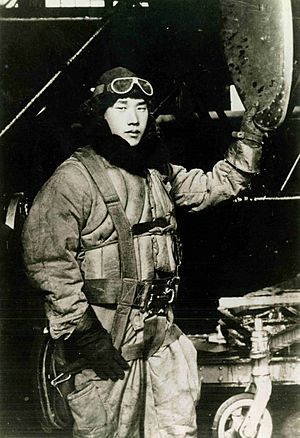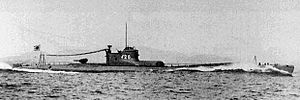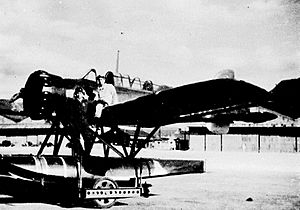Nobuo Fujita facts for kids
Quick facts for kids
Nobuo Fujita
|
|
|---|---|

Nobuo Fujita
|
|
| Born | 1911 Empire of Japan |
| Died | 30 September 1997 (aged 85) Tsuchiura, Ibaraki, Japan |
| Buried | |
| Allegiance | |
| Service/ |
|
| Years of service | 1932–1945 |
| Rank | Warrant Flying Officer |
| Battles/wars | World War II |
| Other work | Unofficial ambassador for Brookings, Oregon. |
Nobuo Fujita (藤田 信雄, Fujita Nobuo) (1911 – 1997) was a Japanese naval aviator. He was a pilot in the Imperial Japanese Navy during World War II.
Fujita is known for a unique mission. He flew a special plane from a submarine. On September 9, 1942, he dropped bombs on southern Oregon. This made him the only pilot from the Axis powers to bomb the contiguous United States during the war. His goal was to start large forest fires. This would make the U.S. military use its resources to fight fires instead of the war.
Contents
Early Life and Military Service
Nobuo Fujita joined the Imperial Japanese Navy in 1932. He became a pilot in 1933. He had a younger brother who also served in the war. Sadly, his brother was killed.
Missions During World War II
Fujita was part of many important missions. He flew a special seaplane called a "Glen." This plane could take off and land on water. It was carried by a large submarine, the I-25.
Pearl Harbor and the U.S. West Coast
Fujita was on the I-25 during the attack on Pearl Harbor. The submarine patrolled north of Oahu. Fujita's plane had a problem, so he could not fly his planned mission.
After Pearl Harbor, the I-25 patrolled along the West Coast of the United States. They attacked U.S. ships. Then, they returned to their base in the Marshall Islands.
Flights Over Australia and New Zealand
The I-25 then went on a mission to explore harbors in Australia and New Zealand. On February 17, 1942, Fujita flew his "Glen" plane over Sydney Harbour. He checked out the city's airbase. After his flight, he put the plane back into the submarine's special hangar.
He also flew over Melbourne in Australia. Later, he flew over Hobart. The submarine then traveled to New Zealand. Fujita flew reconnaissance flights over Wellington and Auckland. He also flew over Fiji.
Bombing Oregon
Fujita himself suggested using a submarine-based seaplane to bomb targets. He thought about attacking the Panama Canal. His idea was approved, and the I-25 was chosen for the mission.
On September 9, 1942, at 6:00 AM, the I-25 came to the surface. It was off the coast near the Oregon and California border. Fujita launched his "Glen" seaplane. He had another crew member, Petty Officer Okuda Shoji, with him. They carried two incendiary bombs. These bombs were designed to start fires.
Fujita dropped one bomb on Wheeler Ridge on Mount Emily in Oregon. The location of the second bomb is not known. The bomb on Wheeler Ridge started a small fire. It was about 16 kilometers (10 miles) east of Brookings, Oregon. Workers from the United States Forest Service quickly put out the fire. Luckily, it had rained the night before, making the forest wet. This stopped the bombs from being very effective.
Two men, Howard Gardner and Bob Larson, saw Fujita's plane. They were at a fire lookout tower in the Rogue River-Siskiyou National Forest. Other lookouts also reported seeing the plane. Many people saw and heard the plane, especially when Fujita flew over Brookings.
After the bombing, the I-25 was attacked by a U.S. aircraft. The submarine had to dive deep to hide. The damage was minor. Fujita flew a second bombing mission three weeks later, on September 29. He used the Cape Blanco Light as a guide. He dropped his bombs and reported seeing flames. However, this second bombing went unnoticed in the U.S.
The two attacks on Oregon in September 1942 were the only times enemy aircraft bombed the contiguous United States during World War II.
Later Life and Friendship
After the war, Fujita continued as a pilot. He later opened a hardware store in Japan.
In 1962, Fujita was invited to visit Brookings, Oregon. The Japanese government made sure he would not be treated as a war criminal. Fujita brought his family's 400-year-old katana (a samurai sword) as a gift of friendship. The people of Brookings welcomed him warmly.
Fujita was very touched by his welcome. He promised to invite students from Brookings to Japan. Even though his company went bankrupt, he kept his promise. In 1985, he helped three female students from Brookings-Harbor High School visit Japan. During their visit, Fujita received a special letter from an aide to President Ronald Reagan. The letter praised his kindness.
Fujita returned to Brookings several times, in 1990, 1992, and 1995. In 1992, he planted a tree at the bomb site as a symbol of peace. In 1995, he moved the samurai sword to a new library in Brookings. He also helped raise money to build the library.
Nobuo Fujita was made an honorary citizen of Brookings. He passed away on September 30, 1997, at age 85. In 1998, his daughter, Yoriko Asakura, buried some of his ashes at the bomb site in Oregon. This showed the lasting friendship between Fujita and the town of Brookings.
See also
 In Spanish: Nobuo Fujita para niños
In Spanish: Nobuo Fujita para niños



